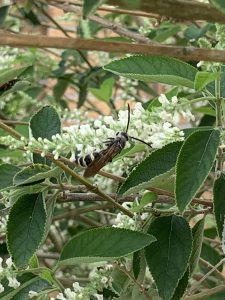With the start of June, we see the shift to our hot and humid summer. This is the month we see our summer flowers start to bloom as we prepare for hurricane season. Anyone that visits our Facebook page (@UFputnamhort) will know that we have several programs going on in June revolving around pollinators. This is because the third full week of June is Pollinator Week. So this Blog will talk about landscaping to-do’s that will revolve around Pollinators.
June is the month to look for heat-tolerant plants. In the vegetable garden, we look at planting okra, southern peas, sweet potato, and calabaza. Many of these also come in a compact size that is great for containers and small space gardens. Okra and southern peas attract several different types of pollinators to the garden. Sweet potatoes, a relative of the morning glory, and the calabaza are pollinated by large bees and beetles. If you are wondering what calabaza is, it is a tropical pumpkin. It grows well in hot summers and is used as winter squash/pumpkins.
There are many different plants available now that would make a great addition to your landscape to add color and provide for pollinators. Herbs like basil, rosemary, and Mexican Tarragon are excellent for cooking and are great pollinator plants too. African Blue Basil is an exceptional variety for pollinators and is most often used as an ornamental. The lesser-known Mexican Tarragon is similar to the French Tarragon but will grow well in Florida. It has yellow marigold-looking flowers that attract a surplus of bees and butterflies.

For ornamental perennials, you can choose a whole host of plants. Pentas are widely available, easy to grow, and come in many colors. They are also a great nectar plant and are attractive to most pollinators in our area. Other common perennials are coneflowers, salvias, shrimp plants, and bush daisies. Two larger plants for a landscape are firecracker plants and firespike. They come in an assortment of colors and are an excellent choice if you like hummingbirds. Another ideal addition to a landscape is the Florida native vine, Coral Honeysuckle. The tubular flowers are great for both hummingbirds and butterflies. If your landscape is very sandy and full of sun, consider the Beach Sunflower. It has small yellow sunflowers that bloom nearly year-round but be careful as it will spread.
Ensure you create an excellent habitat by planting flowering trees and shrubs. The Sweet Almond Bush flowers throughout the summer. As its name implies, it has a sweet scent and numerous flowers that are attractive to bees and butterflies. The Chaste Tree is another small flowering tree (10-15 feet) with spikes of blue flowers in the summer. Palm trees bloom during the summer and attract a vast amount of bees. An additional summer flowering tree to consider planting is the crape myrtle. They come in a wide range of colors and sizes. It is highly recommended that you find a variety that would meet the needs of your site especially when it comes to size. As an extra benefit crape myrtles are trees that do not need extra pruning.

With the decline of many of our pollinators, it is very important to install flowering plants to provide food and habitat. As urban development continues, it’s important that we look at ways to help conserve bees, butterflies, and other pollinators, because we rely on them as many of our fruits and vegetables are dependent upon them for pollination.
Need more help, or looking for specific information? Be sure to contact UF/IFAS Extension Putnam County at 386-329-0318 or putnamhort@ifas.ufl.edu. UF/IFAS Extension is an Equal Opportunity Institution.
Source: UF/IFAS Pest Alert
Note: All images and contents are the property of UF/IFAS.



